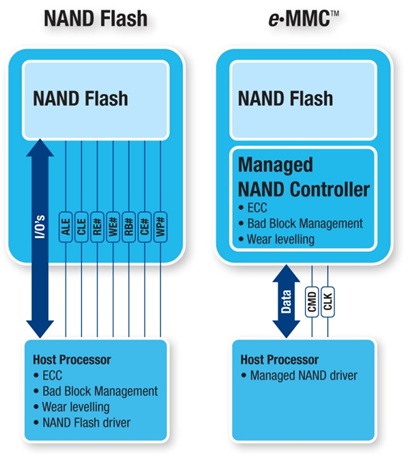Submitted by nbeam85 on

Storage read/write speed is not necessarily a straightforward issue. You can't simply throw more cores at it or crank up the clockspeed because there are a lot of factors that influences overall performance. To keep things relatively simple, I will say that it comes down three areas, the latter two of which are greatly influenced by the first.
The most important factor influencing access speeds is the type of storage used. This is by far the most vital consideration and I will explain why in a bit. The second item is the SoC, the chipset design and overall general processing performance. Finally, the firmware or particularly bits of the kernel that deal with storage, can factor in to access speeds.
So, the type of storage used is a big deal but perhaps for some obscure reasons. Basically, some types of storage are very vanilla and rely on the CPU to do most of the "thinking." Straight up "NAND" storage pretty much relies on the CPU for everything. So the design and performance of the SoC AND how polished the kernel is can heavily influence how well a system relying on NAND storage performs R/W operations. Without delving into the details, NAND is lower complexity and can perform quite well for certain applications. Due to the low cost, here-to-fore it has been the most common type of memory used in low-cost mobile solutions (read "China tabs"...).
Then there is a form of NAND storage that is kind of a step-up that is often called "iNAND" or intelligent NAND. There are different designs but the general idea is that you include a local memory "cache" and some other functionality to greatly enhance NAND storage and increase random r/w speeds (random access is NAND's Achilles heel, local cache can greatly alleviate this bottleneck).
Finally, eMMC is kind of the "Cadillac" of current "affordable" mobile storage solutions. eMMC offloads almost all storage management functions from the CPU onto a dedicated controller chipset that is part of the storage package which also includes dedicated cache (like iNAND). Whereas, with straight NAND and iNAND, some kind of software/firmware interface has to occur between the storage and the CPU so that the CPU can act as a controller (this is much less efficient vs. a dedicated controller on chip). Therefore, in tablets using eMMC storage, the storage access speed bottleneck is much-less-likely to be the CPU or the Kernel.
The "impetus" for writing this article was a post on Slatedroid by user Nickos-V which combined storage performance numbers submitted by several other forum users into a useful comparison of several major devices. I had also recently read some promotional material from one of my favorite emerging Chinese brands, iFive, that advertised the fact that they are differentiating their products by using fast-access eMMC storage. This is a huge step-up in terms of performance for China Tabs as pretty much all of the brands up until now have relied on low-cost / slow NAND storage. The next and final page shows some of the current compiled performance numbers on some of major devices currently available (and some estimated numbers for the new Mini3 HD using eMMC) and briefly discusses them to close us out.
